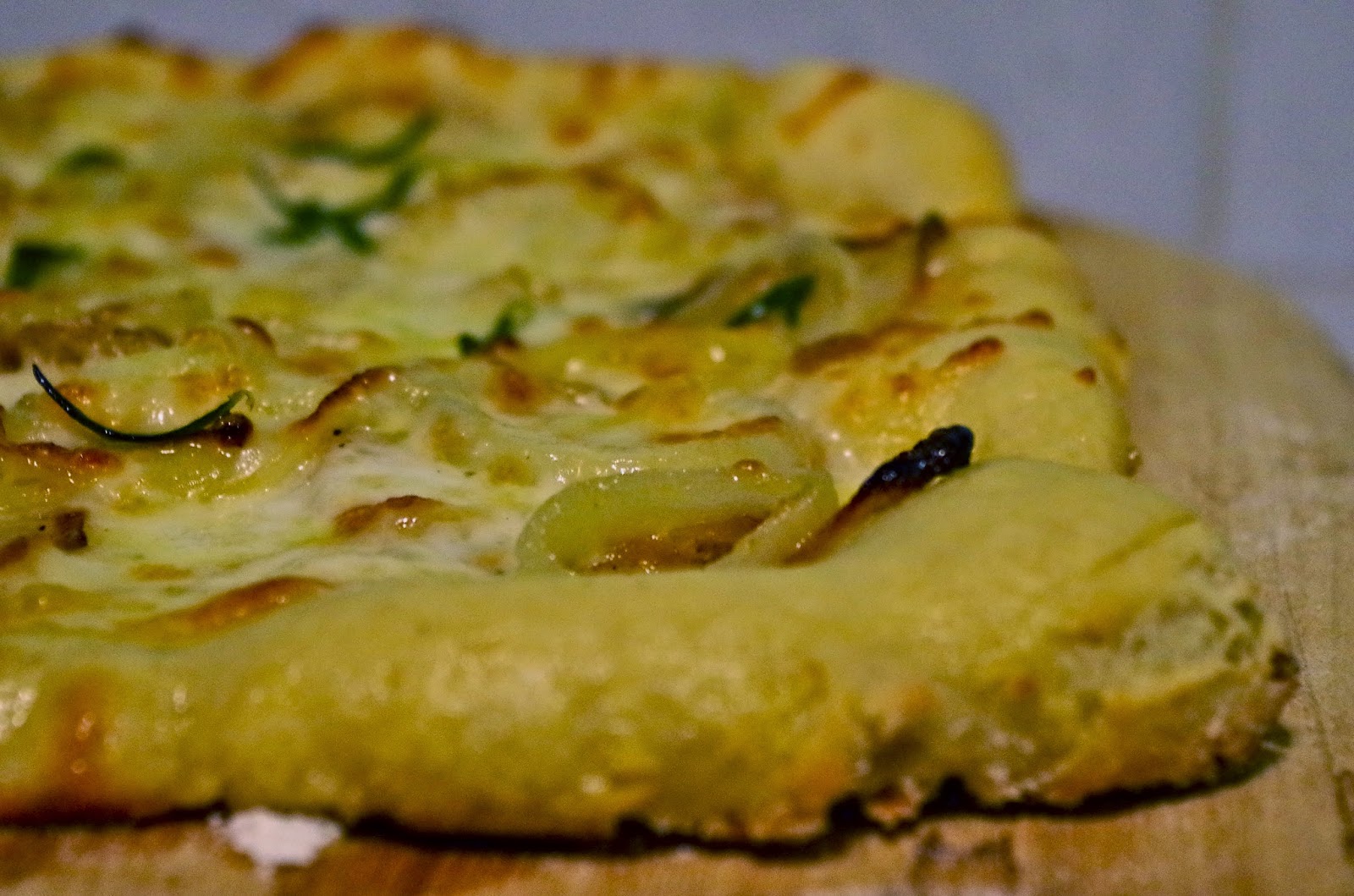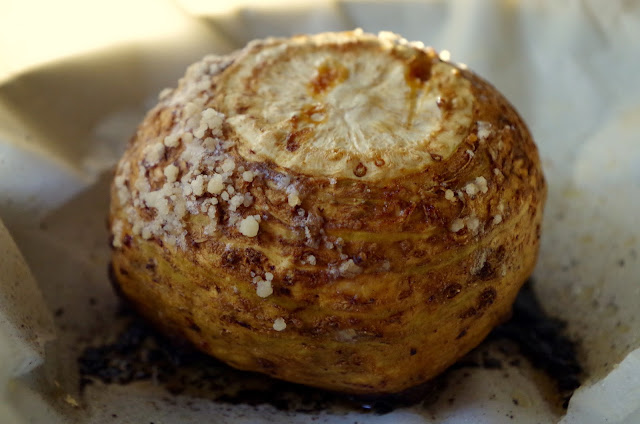Potato Pizza from The Cheese Board
*Okay, Zachary's is stuffed pizza, but I make an exception for Chicago-style pizza, especially in the Bay Area.
As many of you know, I spent two years of my undergraduate
days flipping pies at a pizza shop in central Ohio, so I have a lot of
definitive opinions on pizza making. Thankfully, the Cheese Board’s take on
pizza falls right in line with my own. Or perhaps, one should say my own way of
thinking falls right in line with that of the Cheese Board.
The goal here is to make a crispy, thin crust with just the right amount of sturdiness and crispiness without producing a crust that tastes like cardboard. Then, you have to top that perfect crust with interesting combinations. This recipe provides both. While this potato pizza may seem a little heavy on the starch—what, with dough and sliced
potatoes—don’t let starch aversion keep you from making this pie. It
has been a perennial favorite from this cookbook, so this posting is one that
comes with years of testimonial about its tastiness.
The toppings are simple: thinly sliced Yukon gold potatoes, slightly browned onions, grated mozzarella and swiss, and rosemary. The toppings are savory and smack of the heartiness of winter (if in this case it's the first of the spring--I promise this pizza is great any time of year). Yukon golds are a sweet, waxy potato with lovely yellowed flesh, but if you cannot find them, any red or white skinned, waxy potato will do. The crust is quite easy to make, and the Cheese Board calls for using bread flour. Bread flour has a higher protein content, which allows for a crispy bit of magic to take place (okay, that magic actually comes in the form of gluten development, but let's call it magic). This magic allows for the dough to have even more strength and structure--much needed properties when you plan to load up on toppings (which we, indeed, do plan to do). See here for even more answers to your flour-based questions. However, if you don't have bread flour, don't worry. Just use regular, all-purpose flour. Your dough will be slightly chewier, but it will still be just as tasty.
Everything else is as easy as, well, (pizza) pie.
The last time I posted from this cookbook, the husband had
just finished graduate school; he was on the lookout for gainful employment,
and unfortunately, the very night we made the four-cheeses pizza, he got an email that a newly created job for him was not going to fly. What followed
was an extensive and drawn-out search for a job that finally landed on one some
six months later. As I said in that post, after that email, we redirected our focus onto the pizza--well, not the pizza necessarily, but onto just sharing this one meal together. And things did, indeed, work themselves out.
This time around, cracking open the cookbook to page 215 was far more joyful; we made this pizza up in Fort Bragg, at the in-law’s home (I can't quite figure out the light in their kitchen, so I am never entirely pleased with my photographs that I take there).
They purchased this little cabin in the woods with the intention of slowly
converting it into their retirement home. With new windows and an expansive
deck, with newly-trimmed trees to afford a view of the ocean and recently torn
down walkway structures, the house is beginning to feel like their home, filled
with light and warmth from a cozy, wood-burning stove (which sadly, does not double as a pizza oven).
The husband and the father-in-law spent the morning walking into town for handmade tacos to be procured from the all-purpose room of a local church, while the mother-in-law and I sat overlooking redwoods, sipping coffee or tea and eating homemade bread. Then the husband and I went into town to the shop for the goodies for this recipe, and that evening, we along with a guest up from the Bay Area ate around the table with windows overlooking a soon-to-be rehabilitated garden, filled with deer-resistant plants. The moon was full, but even on such a bright night, the sheer number of stars makes you feel small but cozy. This recipe from this cookbook, admittedly, seemed a lot better.
The husband and the father-in-law spent the morning walking into town for handmade tacos to be procured from the all-purpose room of a local church, while the mother-in-law and I sat overlooking redwoods, sipping coffee or tea and eating homemade bread. Then the husband and I went into town to the shop for the goodies for this recipe, and that evening, we along with a guest up from the Bay Area ate around the table with windows overlooking a soon-to-be rehabilitated garden, filled with deer-resistant plants. The moon was full, but even on such a bright night, the sheer number of stars makes you feel small but cozy. This recipe from this cookbook, admittedly, seemed a lot better.
-------------
Potato Pizza
Yield:
Three 10-inch pizzas (one can easily split this into thirds, if one is not so inclined for so much pizza)
Ingredients:
2-3 Yukon Gold potatoes, thinly sliced
8 tbsp olive oil
1/8 tsp salt
1/2 tsp pepper
2 yellow onions, thinly sliced
1 sprig rosemary
1 recipe for Yeasted Pizza Dough (recipe follows)
Fine yellow cornmeal or flour for sprinkling
2 1/2 cups (10 ounces) shredded Mozzarella cheese
1 cup (4 ounces) shredded Swiss Gruyere cheese
1/2 cup loosely packed fresh flat-leaf parsley, coarsely chopped
Instructions:
1. Arrange the oven racks in the upper and lower thirds of the oven. Preheat the oven to 450 degrees. If using a baking stone, preheat the baking stone on the bottom of the oven for 45 minutes.
2. Line a baking sheet with parchment paper. Toss the potatoes with 2 tablespoons of the oil, the salt and pepper. Arrange the potatoes on the prepared pan. Bake for 15-20 minutes, or until the slices are almost completely cooked through. Let cool.
3. Meanwhile, combine the onions and 2 tablespoons of the olive oil in a heavy medium skillet. Cook, stirring occasionally, over medium-low heat for 10-12 minutes, or until the onions are soft and golden brown. Set aside to cool.
4. To make the rosemary oil combine the remaining tablespoons olive oil and the rosemary sprig in a small saucepan. Cook over low heat for 5 minutes, taking care that the oil doesn't bubble. Turn off the heat and let the oil cool in the pan.
5. To shape the pizzas, transfer the dough to a lightly flowered surface and divide it into 3 pieces. Gently form each piece into a loose round and cover with a floured kitchen towel. Let rest for 20 minutes. Scatter cornmeal over 3 inverted baking sheets or a pizza stone. Shape each round into a 10-inch disk.
6. Mix the cheeses together. Line up the 3 pizzas for assembly. Sprinkle half of the mixed cheeses over the pizzas, leaving a 1/2-inch rim. Scatter the caramelized onions on top of the cheese and layer the potato slices on top of the onions, spacing them at least 1/2 inch apart. Sprinkle with the remaining cheese.
7. Place a baking sheet with a pizza on the lower oven rack and bake for 8 minutes. Rotate the pizza to the upper rack, place the second pizza in the oven on the lower rack, and continue baking for 8 minutes. Then, finish baking the first pizza by sliding it off the pan directly onto the baking stone. Rotate the second pizza to the upper rack and put the third pizza in the oven on the lower rack. Bake the pizza on the stone for 4 minutes to crisp the bottom until well browned. Finish baking the second and third pizzas in the same manner.
8. Immediately after removing each pizza from the oven, brush the rosemary oil on the rim and drizzle it over the rest of the pizza. Garnish with the parsley.
To make the dough
Yield:
Three 10-inch pizza crusts
Ingredients:
1 tablespoon active dry yeast
1 1/2 cups warm water
2 tablespoons extra virgin olive oil
1 1/2 teaspoons kosher salt
3 1/2 to 4 cups bread flour
Instructions:
1. In a large bowl, whisk the yeast into the warm water until dissolved. Let stand for 5 minutes.
2. Add the olive oil, salt, and 2 cups of the flour to the bowl. Using a wooden spoon, mix for at least 5 minutes to form a wet dough. Pour 1 1/2 cups of the flour onto a work surface, place the dough on top of it, and kneed for about 8 minutes to form a soft dough with a nice sheen; it should be a little sticky, but not too wet. If the dough sticks to the work surface, rub a little olive oil on it. If the dough is impossibly sticky add the remaining 1/2 cup flour by the tablespoon as needed.
3. Form the dough into a ball and place it in a large oiled bowl. Turn the dough over to coat it with oil. Cover the bowl with plastic wrap or a damp kitchen towel and let rise in a warm, draft-free place for 1 hour, or until doubled in size. Or, put the dough in the refrigerator and let it rise overnight; the next day, let it stand at room temperature for 2 hours before proceeding with the recipe.









Comments
Post a Comment